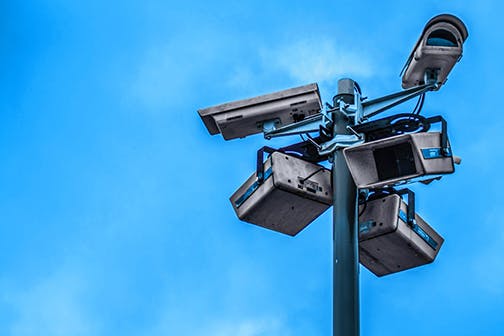
If you’ve ever shopped around for security cameras, you know firsthand that there are a seemingly endless amount of cameras to decide between. Some cameras are used exclusively in business settings and others are used residentially. With so many options, it can be overwhelming to learn about the different types of security cameras.
This article is a quick guide to several of the different types of security cameras. While we do not sell all of the cameras explained in this guide, the cameras listed here are commonly used and helpful to know about. Keep reading to learn more about motion activated cameras, infrared cameras, game cameras, window cameras, CCTV cameras, box cameras, dome cameras, turret cameras, PTZ cameras, bullet cameras, IP cameras, NVR, DVR, and PoE cameras.
Motion Activated Camera
Motion activated cameras constantly monitor the area where they are positioned, but they only record footage when they detect motion. This eliminates unwanted surprises, decreases crime, and increases your peace of mind. The motion sensor inside of a motion activated camera uses infrared technology to detect movement within its field of view. This technology is implemented in a few different ways to create the security cameras that we use today. You can read more about infrared technology in the section below. Another type of motion activated camera technology determines if movement has taken place by comparing pixels in images it captures of its environment. This type of camera utilizes motion sensor lighting. Whenever the camera detects a drastic enough change in lighting (like, say, a person’s shadow), its sensor activates and it begins recording footage. Whenever your camera’s sensor is activated, it will begin recording video and send an alert to your security system’s control panel. Cameras today also come equipped with apps that you can download on your mobile device. This means that you can get notifications in real time as your camera detects activity.
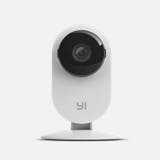
Infrared Camera
Infrared cameras use infrared technology to detect motion and heat. Infrared technology is common in most types of security cameras. Infrared sensors are found in almost every type of security camera, most especially in conjunction with motion activated cameras. Light above a certain spectrum is undetectable by humans, and most animals aren’t capable of noticing it either. Cameras that transmit infrared light emit little (if any) glow, making detection nearly impossible. The more stealth you want your camera to have, the higher quality your infrared emitters should be. One way infrared technology is used is to detect blocked signals. If an object crosses in front of the signal a motion sensor emits, it will alert your security system’s control panel and send you a warning that there could be suspicious activity taking place at or in your home. There are also cameras that utilize infrared technology to detect heat, thus activating the motion sensors when there is a sudden change in temperature in the camera’s field of view. You may know this as a thermal camera. These cameras are especially useful for detecting body heat. You can even adjust the settings for your camera so that your infrared sensors don’t react every time your pet walks though your kitchen. Infrared sensors also aid with night vision. Crime and suspicious activity don’t take place exclusively during daylight hours, so a security camera that has night vision technology is good to have for your home. Cameras with night vision utilize infrared lights to capture clear footage, even in the dark. Once it starts getting dark a camera with night vision switches into night mode, relying on infrared illuminators to capture well exposed photos or videos of its surroundings.
Wired Camera
Wired cameras are the oldest form of security camera. They rely on wires to get power. Wired security cameras are the oldest, longest standing form of security camera. These cameras have two important wires: one that connects to a power source, and another that connects to your home’s landline. Cameras that monitor through the landline do not need batteries but do require professional installation. These cameras typically store footage on a memory sd card that is found inside of the camera.
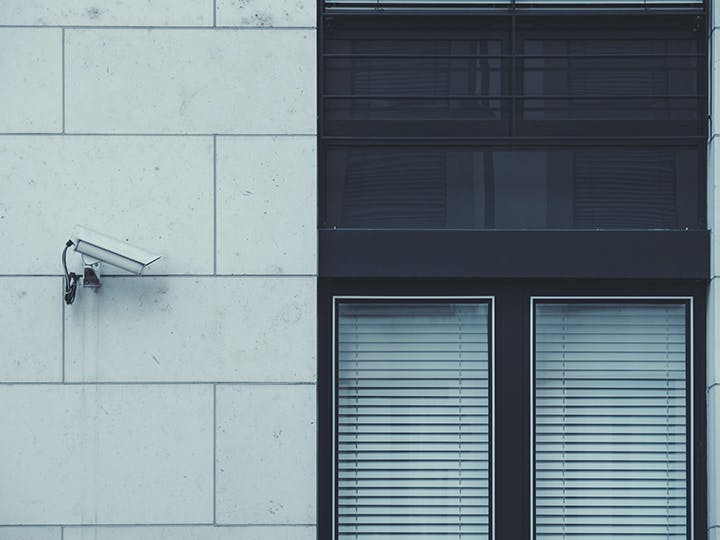
Wireless Camera
Wireless cameras do not require landline connection to function. They do, however, require a wire that connects them to a home’s landline. Wireless security cameras differ from wired security cameras in that they do not require a connection to your home’s landline to function. Instead, they connect to your internet via WiFi. That is where the title “wireless” comes from. Contrary to what their name may lead you to believe, though, wireless security cameras still require a physical wire that connects them to a power source. The cord that powers a wireless camera plugs right into your wall, so it is essential that these cameras be placed near an outlet. This can potentially limit placement options around your home. Most wireless camera models have backup batteries so that they can still perform their function in the event of a power outage. Since they connect to your home’s WiFi, wireless cameras can upload video to your online storage. In the event of connectivity issues, however, wireless cameras can also store footage on a local memory card. Since this type of camera does not have to connect to any landlines, you do not need professional installation help to start monitoring your property.
Battery Operated Camera
Battery operated cameras are wire-free and powered only by batteries. Battery operated security cameras are truly wire-free cameras. These cameras source their power from batteries, no wires attached. They have the same connectivity capabilities as wireless cameras, so footage can be uploaded to an online storage system or saved locally on a memory card. Battery operated security cameras are the easiest type of camera to install. All that you have to do is put batteries inside, turn the power on, and position each camera wherever you want it. The placement possibilities are endless. Untethered by wires, both connectivity and power source-related, battery powered cameras can be set up as far from your home’s outlets as you like.
Game Camera
Game cameras are outdoor cameras that were invented to assist hunters in their endeavors to track wildlife. These cameras can be used for hunting and around your house to keep your house safe.
Game cameras are high-quality devices that were invented for the purpose of tracking wildlife creatures in their natural habitat with minimal disturbances. These cameras can be used around the home to keep your property safe. Game cameras are battery operated, weatherproof, and use infrared technology to capture footage with remarkable speed. Many types of game cameras are available, so whether you want the ability to take photos, film video, or capture a time lapse, these gadgets have got you covered. There are also varying storage options, including wireless and memory card.
Game cameras capture high-quality photos upon detection of motion within their line of sight. This motion sensor makes them ideal for capturing footage of unwanted activity on your property. A game camera can be a valuable addition to your security system if you have a current, persistent security problem like a recurring trespasser that you want to catch on film. They can also be used in anticipation of future problems, like if you want to be sure you have footage if someone were to ever break into your house. Photos taken by game cameras offer excellent image quality and resolution on both bright days and cloudy evenings. Infrared night vision will help capture the best nighttime images.

Window Camera
Second only to doors, windows are an easily accessible entrance to your space. A determined intruder can force a lock, break the glass, and shimmy inside. Safeguarding your windows is just as important as safeguarding your doors. One excellent way to protect your windows is to use a window camera. This camera can monitor movement around your home and keep a record of suspicious activity taking place on your property. A window camera can also record an intruder’s face if they decide to try and enter your home through the window.
There are many types of window cameras. Some use motion detection while others use thermal sensing technology. You can also use window cameras inside or outside. If you want to use a window camera indoors, though, it’s probably best to avoid a thermal camera. An indoor camera that is placed extremely close to a glass window pane will experience some flux in temperature as the seasons change. Windows today are insulated so the weather outside will typically have a minimal effect on the inside of a building, but insulation weakens over time. A window that has old insulation can experience more drastic temperature changes and can even collect condensation inside.
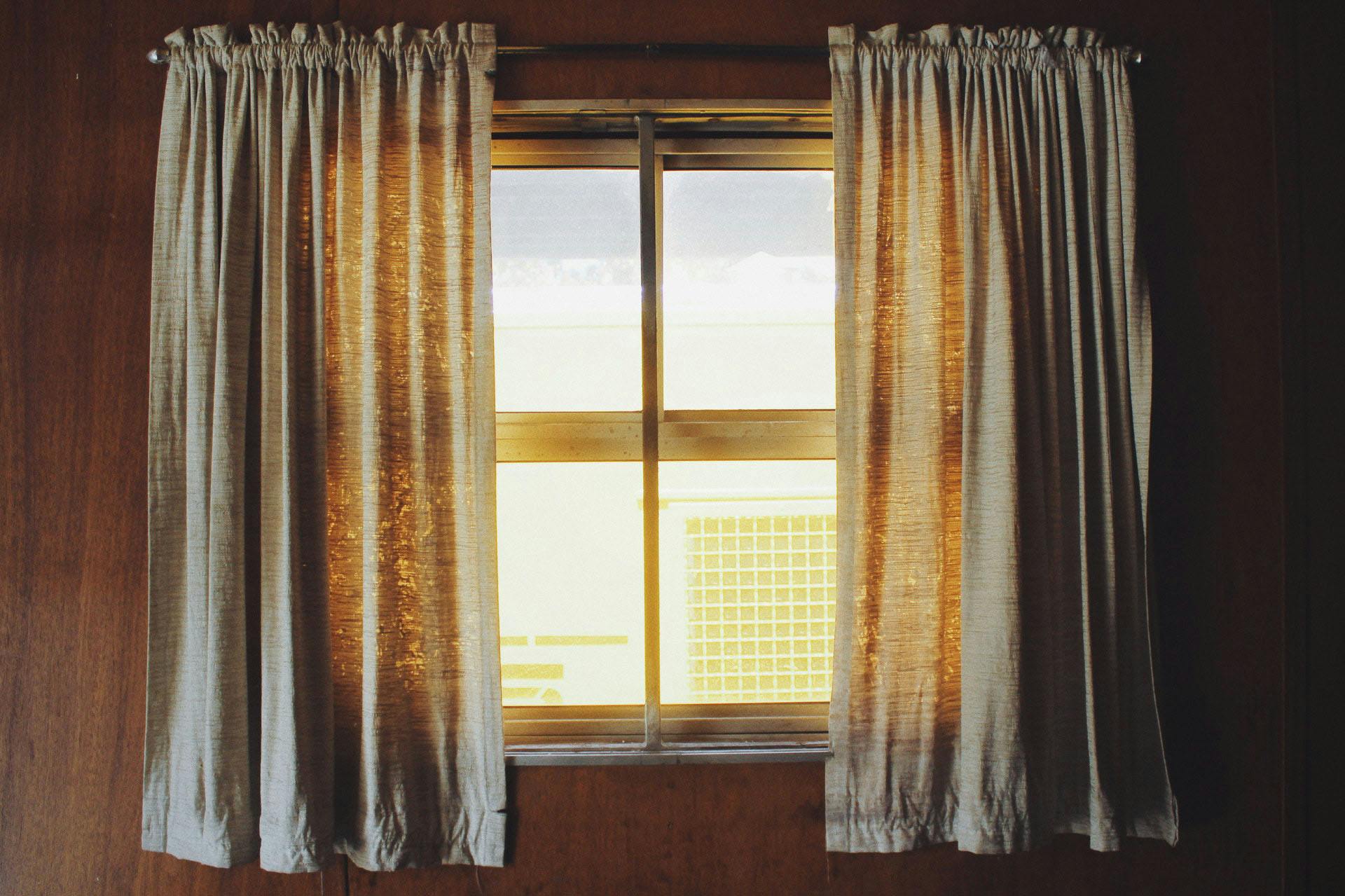
CCTV Camera
CCTV stands for closed-circuit television. A CCTV camera is a type of video surveillance that records and stores video footage in a closed circuit while broadcasting footage to a television monitor. There are many CCTV camera designs.
A closed-circuit television (CCTV) camera is a system that is frequently used to monitor the perimeter around or the area inside of a business. It is more commonly referred to as video surveillance. This type of cameras is primarily used for security and surveillance. It is a tv system where signals are held inside of a closed circuit (as implied in the camera’s name) and broadcast to a television monitor.
The word “tv” conjures up images of television shows and broadcast signals. A CCTV camera, however, should not be confused with a regular television. It differs from broadcast television because the signals that CCTV cameras transmit are, as stated in the name, closed circuit. This means that the signals are not publicly distributed and that the monitor does not pick up on publicly distributed signals. Instead, the monitor only receives a signal from the cameras installed around the premises. Additionally, only those who have access to the monitor that the individual cameras transmit to are able to see the security footage those cameras capture. They are specifically designed so that only those who have access to the monitor can see the camera footage.
A CCTV camera monitors events in real time. It can also record and archive footage to be watched at a later time. Cameras in a CCTV camera surveillance system are strategically placed to capture some footage of every part of the building that they monitor. They have several uses, including monitoring traffic, incarcerated persons, medical patients, and businesses (especially high-security businesses like banks, jewelry stores, or airports).
Almost all business security camera surveillance systems use some type of CCTV camera. And, while not all cameras are CCTV cameras, many of the cameras discussed below do fall into this category.
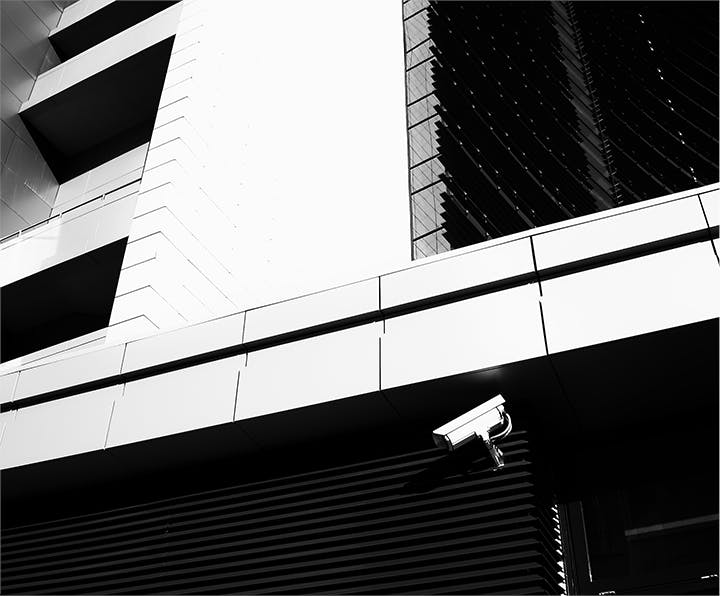
Box Camera
A box camera is a type of CCTV camera. All of the components of a box camera are highly customizable, making them a popular camera type.
A box camera is one type of CCTV camera that you can purchase. Box cameras get their name from their boxy appearance. They are CCTV cameras of professional quality, and they are very customizable. Those who use a box camera can design a camera to fit their specific needs. You can customize a box camera’s level of weather resistance, lens type, resolution, signal type, and whether your camera is wired or wireless. Everything is customizable to fit your specific needs. And, since they are so customizable, box cameras can be altered bit by bit even after you have already purchased a camera. It is easy to change the camera’s lens or body as your needs change. This is true even after you have been using your camera for some time.
A box camera will typically outlast a bullet camera or a dome camera (both of which you can read more about below).
Dome Camera
A dome camera is a type of CCTV camera. Dome cameras can be recognized by their distinctive dome shape. They are typically used to monitor businesses.
A dome camera is a variety of CCTV camera that you have probably seen inside of grocery stores or gas stations. The dome camera gets its name from its distinctive dome shape. The part of the camera that captures footage in a dome camera sits inside of the dome.
If a business uses a dome camera, it is usually mounted in the ceiling or high up on the wall. The dome is sometimes tinted so that the direction that the camera is facing can be obscured. This, and the fact that this type of camera is generally a bit more durable, make the dome camera a popular security camera. Since the lens of the camera is concealed within the dome, these cameras are less likely to be ruined by vandalism. Replacing a plastic dome is much less expensive than replacing an entire camera.
A dome camera is generally able to capture a wider angle than a typical surveillance camera. The camera can also swivel within the dome, offering a wide range of coverage from each camera position.

Turret Camera
A turret camera looks like a miniature dome camera. It has a ball and socket design that allows the camera to swivel. Turret cameras are long lasting, popular security cameras.
A turret camera is essentially a miniature dome camera. The two are similar in appearance and work in essentially the same way. Turret cameras are used in both business and home settings, but you may be more likely to find them in a commercial setting. Turret cameras are flat-faced. They somewhat resemble an eyeball, and have been given that nickname. The ball and socket design of a turret camera allows it to swivel around in its base and monitor more space than a traditional, fixed camera.
Though turret cameras look like miniature dome cameras, the two camera types do have some differences. In fact, the turret camera is becoming more popular than dome cameras and bullet cameras. Here are a few reasons why: While dome cameras have the actual camera stored safely behind a plastic or glass frame, turret cameras have the camera lens and infrared lights on the device’s face. This reduces glare effect. Turret cameras are smaller and cheaper than bullet or dome cameras. A Turret camera’s unique design makes it less likely to attract spider webs . It is easier to adjust the angle on a turret camera than on a bullet camera or a dome camera. Turret cameras have a less intrusive design than both bullet and dome cameras.
Turret cameras are typically PoE cameras because it is difficult to make the camera’s unique structure adaptable to a wireless infrastructure. Though it is less common, they can also be IP cameras. You can read about both of these camera varieties below.
PTZ Camera
PTZ stands for pan, tilt, zoom. A PTZ camera has a variety of uses, including business surveillance, video conferencing, and professional television recording.
PTZ stands for pan, tilt, zoom. This camera’s name describes the different actions that the camera can perform. These three unique functions give the PTZ camera the ability to monitor a large area that might otherwise require multiple fixed cameras. Though PTZ cameras require fairly minimal installation, you will likely not find one in someone’s home.
At a glance, it may be hard to distinguish a PTZ camera from a dome camera. Both cameras are encased in a tinted, hard plastic or glass dome that obscures the direction that the camera is facing. Where PTZ cameras and dome cameras differ is in their potential. PTZ cameras can perform a wider range of functions, including zooming and remote direction changing. Another major difference between the two is that while dome cameras are used almost exclusively for security purposes, PTZ cameras have a variety of uses. They are especially helpful for business surveillance, but they are also used for video conferencing, distance learning, and live production. In the tv production world, these cameras have been given the nickname “robo,” which is short for robotic camera. They are used in conjunction with professional cameras in television production.
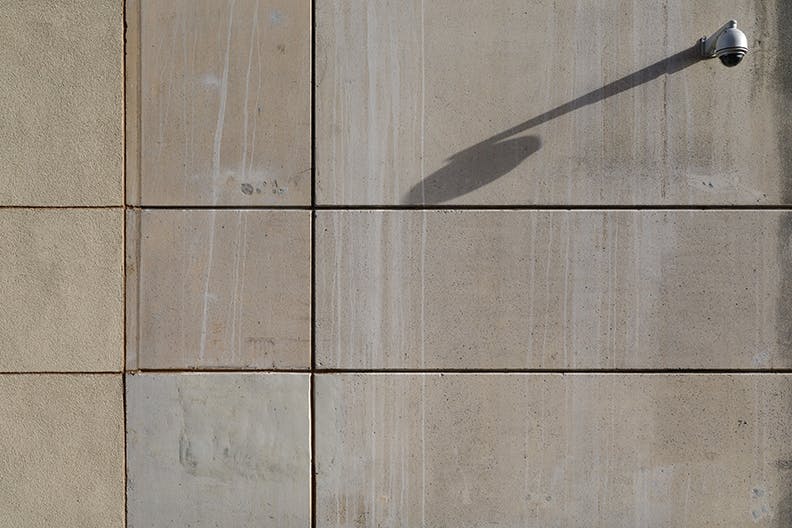
Bullet Camera
A bullet camera is a type of CCTV camera. It is typically placed outside of businesses to deter thieves. Bullet cameras are designed to be weather resistant.
A bullet camera is another type of CCTV camera that is usually used around businesses like manufacturing plants or farmhouses. You will probably recognize bullet cameras from going to grocery stores or other places of business in your day to day life, but you will probably recognize them more especially from seeing them in movies or tv shows. Bullet cameras are the cameras that burglars usually cover with spray paint when they sneak into a business. And, as you’ve probably seen in the movies, bullet cameras send their footage to a local monitor that transmits the footage which they capture for someone like a security guard to see.
Bullet cameras were not designed to be concealed. They are highly visible and iconically shaped. Each bullet camera is usually installed high up on a wall so it has a good field of view and can see long distances. Since they are typically used as an outdoor security camera, they are specially designed to be weather resistant. This means they can hold up against water, and dirt. It also means that the gears and joints on the camera are strong, making each camera resistant to changing angles in strong wind. And, since they have a protective casing, the camera also has a hood over the lens. This reduces the effect of rain droplets and sun glare in obscuring the camera’s footage.
People who use bullet cameras in their video surveillance system want to send the message that they are watching over their property. These cameras are intimidating and act as an effective deterrent to those who might be considering stealing or vandalizing a business. Their distinct design decreases criminal activity.
Since bullet cameras are able to capture high-quality footage, they are recommended for use around businesses. They are considered best for outdoor security camera use because of their durability and their ability to effectively tell passersby that the area is under surveillance.

IP Camera
IP stands for internet protocol. An IP camera is a surveillance camera that shares live footage via the internet to those who have access to the feed. Since an IP camera uses the internet, those who have the proper credentials to see the footage can access it from anywhere around the world.
Internet protocol (IP) cameras are surveillance cameras that share live footage via the internet. Since footage is shared over the internet, this means that the footage an IP camera captures can be accessed from anywhere in the world with internet or wifi capabilities. And, since the footage from an IP camera can be viewed from anywhere with an internet connection, stored archival footage can be similarly accessed from a computer or smartphone.
Streaming and archiving video takes a lot of storage space. As an IP security camera captures footage, it also compresses the video it takes. Compressing the bandwidth of video footage makes the transmitting speed faster and the online feed more reliable. It also allows the cameras to capture sharp, high resolution images.
The internet streaming capabilities of an IP camera let viewers remotely control the camera. A viewer monitoring camera footage from across the world can zoom and reposition the camera with the push of a few buttons. For these reasons, an IP camera is the ideal type of security camera for individuals who frequently find themselves gone on business trips, off-site, or otherwise away from their office.
There are many advantages of using an IP security camera for video surveillance. Since these cameras are compatible with the internet, they can sync with your smartphone to send you notifications if they detect any suspicious movement on your property. Connecting to the internet also means that an IP camera has the potential to be hacked. Although this sounds scary, there is no need to fear. These cameras are also low maintenance and offer impressive security since they can use encrypted data. IP cameras have higher resolution than many of their competitors. They require less cables than many security cameras, making setup easier and the mess that they cause minimal.
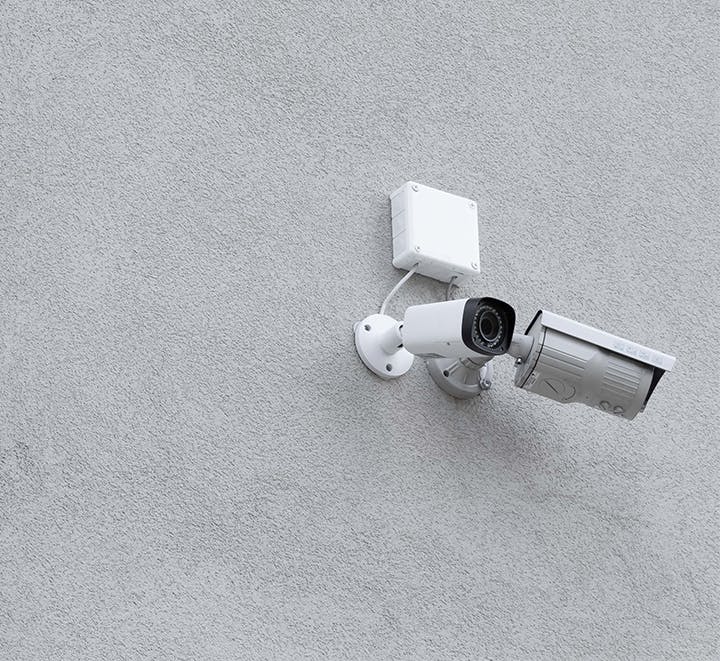
NVR: Camera Assistance
NVR stands for network video recorder. An NVR is a device that works with IP or PoE cameras to store archival video footage.
Network video recorders (NVR) work hand in hand with IP cameras. Any time an IP camera captures video, it needs somewhere to store the archival footage. An NVR is the device that stores the archival footage so that it can be viewed at a later time. An IP security camera connects to an NVR via a router or network switch. And, just as you can access footage from an IP camera from a remote location, you can use a computer or a mobile app on your smartphone to access the NVR and view video footage.
An NVR system can be either wired or wireless, depending on your preference. They can store footage directly from the network that they connect to. Since an NVR holds special security footage, it should be stored in an area where it is secure but can also have access to the necessary wiring (if you have a wired NVR). Wherever you place your NVR, be sure that you have it set to back up regularly so that you don’t lose any footage.
One NVR connects to multiple IP cameras. The number of cameras that an NVR can accommodate will depend on the bandwidth and the type of NVR that you purchase. If you want a device that can handle many different cameras, make sure that you purchase one that can handle the load of multiple cameras.
An NVR can also work with a PoE camera, which you can read about below.
DVR: Camera Assistance
DVR stands for digital video recorder. A DVR is an analog device that works with analog cameras to store archival video footage.
A digital video recorder (DVR) system is the analog counterpart to an NVR. Where an NVR stores footage from an IP camera, a DVR stores footage from an analog camera. Years ago, analog cameras used to have to store the video that they captured on videotapes. Since videotapes are no longer a practical means of storing recordings, we needed a new system to capture and hold footage. Since technology advances so rapidly in today’s fast paced world, analog cameras are becoming less and less popular as the years go by. Many companies still use analog cameras for video surveillance, though, and a DVR allows those who still use analog cameras to have a practical means of storing their video footage.
A DVR does not have an unlimited amount of storage space. When someone purchases a DVR, they indicate the resolution and frames per second that they want their camera to capture. The larger the resolution and the more frames per second, the more storage space the footage will require. And, when a DVR’s storage disk gets full, it will continue saving its recordings by taping over the oldest footage on file. If your camera hasn’t captured anything of note, recording over it will probably cause you no worry. But, if you have important footage that you want to keep record of, you will have to monitor your DVR to make sure that its storage does not get too full.
It is possible to buy equipment that essentially transforms a DVR into an NVR if you are making the transition from analog cameras to digital cameras, but the change requires time and a bit of knowledge about how the cameras work. It may be more convenient and cost effective to simply turn in your DVR and make the leap to an NVR if you are switching from an outdated camera type to something more modern.
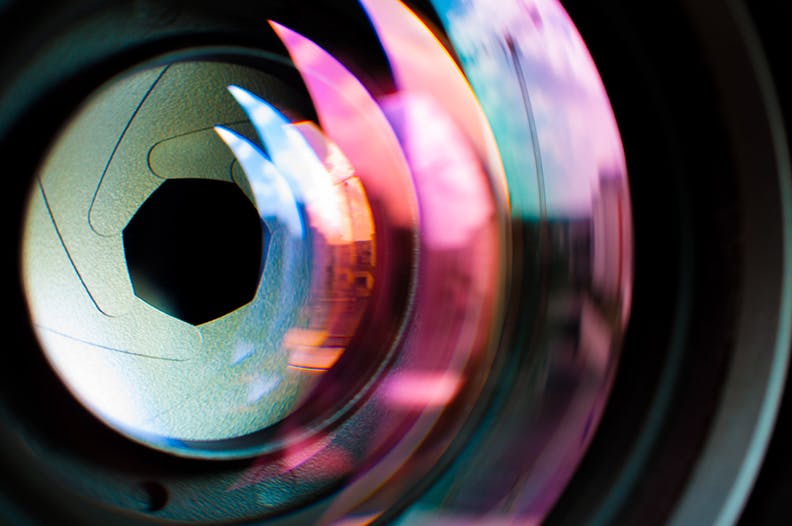
PoE Camera
PoE stands for power over ethernet. A PoE camera requires a single ethernet cable to supply power and the ability to store video footage. PoE cameras require minimal installation.
PoE stands for power over ethernet. While some technologies in this article are commonly used in places of business, PoE cameras are more frequently found in residential areas. This type of camera uses an ethernet cable to connect a security camera to a camcorder. The security camera captures the footage, and the camcorder stores it. The ethernet cable allows the two separate devices to communicate with each other, thus enabling one to take video footage and the other to store it. The cable also powers the camera.
Since a PoE camera only requires a single ethernet cable, to supply power and connection to a camcorder, this camera type is easy to use and requires minimal installation. There won’t be tricky wires that you have to worry about tripping over or tucking away. All you have to worry about is where to place your camera for the most optimal vantage point of the area you want to monitor.
Since people usually want more than one solitary security camera in their home, a PoE camera system will likely require a PoE switch. PoE switches are devices with multiple ethernet ports. Multiple ports means that the device can support multiple cameras. A PoE switch is also compatible with an NVR, meaning that you can connect all your devices in at one location. The PoE port can connect your cameras and NVR so you can more easily manage your both security devices and footage.
You do need access to a router in order to use PoE technology. A router makes your cameras visible on an IP network and ensures that the NVR will be able to connect to the internet. Not all network switches support PoE cameras, so you may have to buy one specifically for this purpose if you have decided to use a PoE camera system in your home.
Since your PoE camera connects directly to your ethernet, the image quality of these cameras is superior to other types. The ethernet connection means that the cameras can capture footage at a higher bandwidth than cameras with wireless connection are able to manage. PoE cameras are excellent at capturing facial features and small details like license plate numbers.
While PoE cameras do an amazing job of capturing video footage, they do have some downsides. They are harder to install than wireless cameras. They do require the use of an ethernet cable, and for some using one wire is one wire too many.
